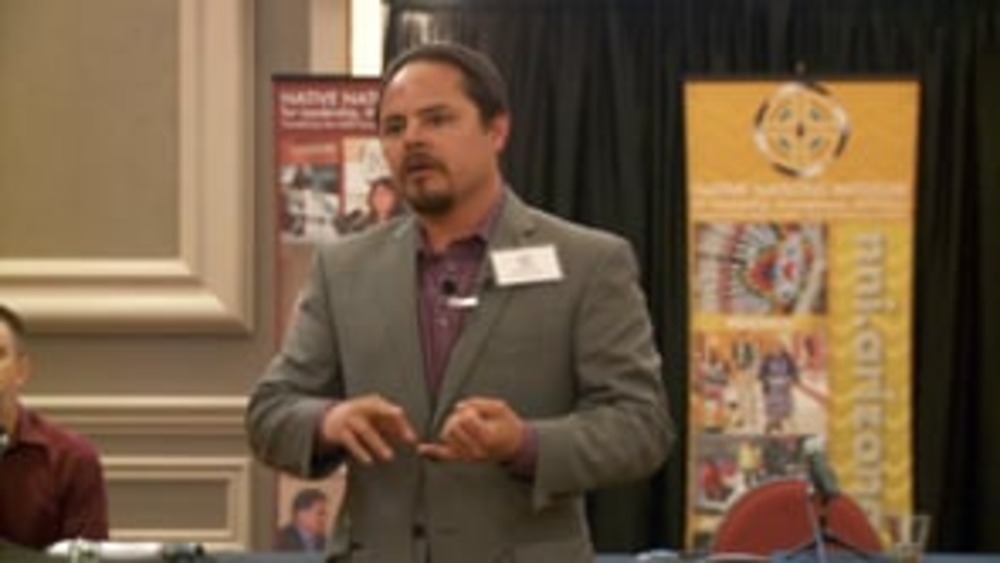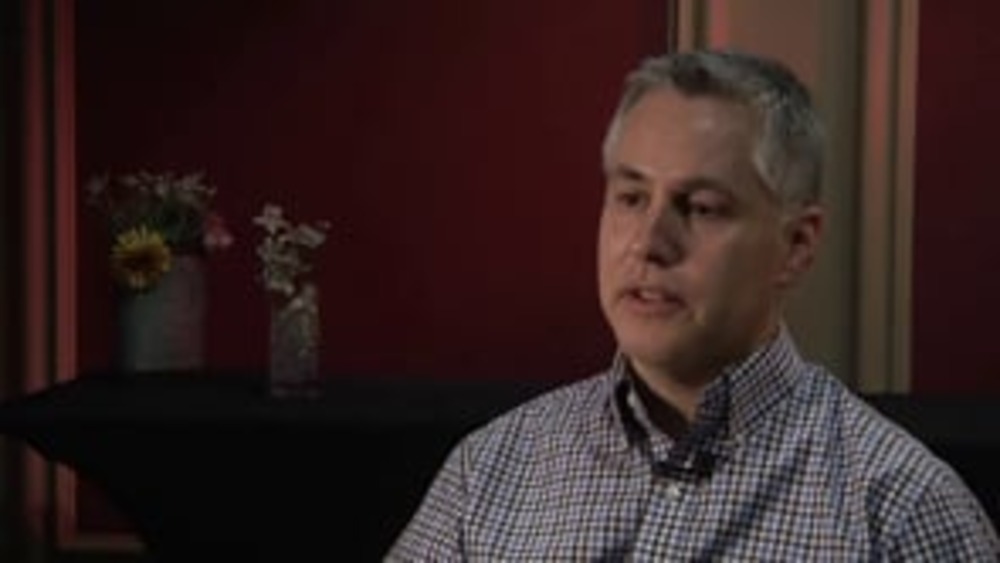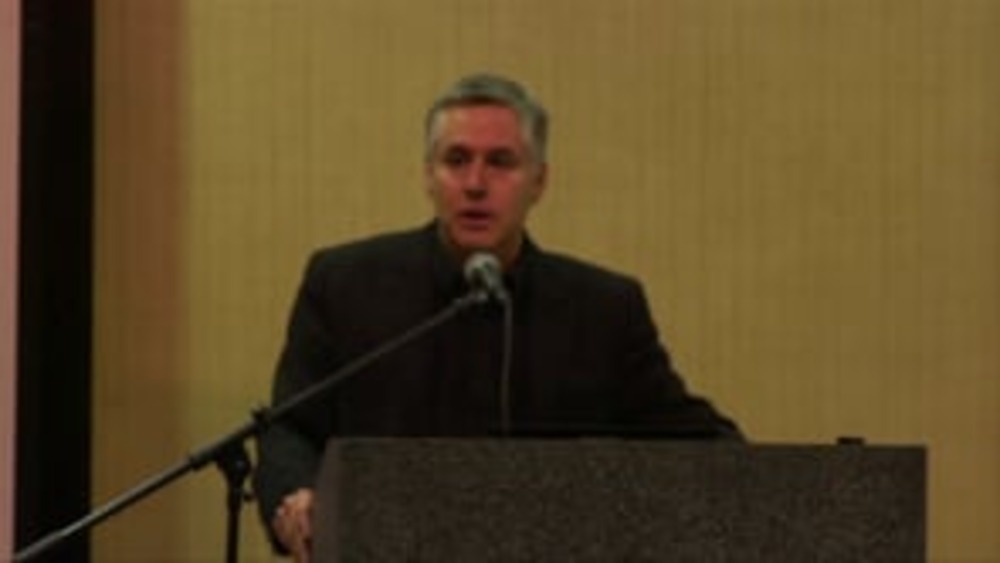University of Minnesota Law Professor John Borrows (Anishinaabe) discusses how the Anishinaabe traditionally defined and practiced notions of social identity and belonging, and how those definitions and practices were rooted in relationships: relationships between those deemed to be part of the group, as well as their relationship with the natural world. He recommends that Native nations consider their own, Indigenous notions of identity and belonging as they tackle the challenge of determining what criteria for citizenship make the most cultural sense for them today.
Additional Information
Borrows, John. "Who Are We and How Do We Know?" Tribal Constitutions Seminar, Native Nations Institute for Leadership, Management, and Policy, University of Arizona. Tucson, Arizona. April 2, 2014. Presentation.
Transcript
Ian Record:
"I have the great honor of moderating this next session. We're at session two in your agenda and in your booklets and the title of this session is "Key Things a Constitution Should Address: Who Are We and How Do We Know?" And we're going to be tackling a number of critical aspects of what we've identified from our ongoing research as key things that a constitution should address. It's not to say that these are all of the key critical issues, but the ones that we most often hear are issues that Native nations are struggling with, are tackling as they engage in answering this question of does this constitution meet those tests that Joan [Timeche] left you with at the end of the last session. And one of the most critical areas that we see tribes, First Nations in Canada struggling with is this issue of identity, of citizenship, of answering that question of who are we and then how do we either define or redefine a process by which we determine who can be a part of us. And we have the great fortune today to have with us a distinguished series of panelists and I will introduce them very briefly and then leave it to you -- if you wish to learn more about who they are -- to consult the rather lengthy biographies in your booklets there.
But the first panelist we're going to hear from is Professor John Borrows. John is a citizen of Ontario's Chippewas of Nawash First Nation, an Anishinaabe, and he joined the faculty at the University of Minnesota's School of Law back in 2009. Many of my colleagues know John well and regard him as one of the most innovative and influential thinkers and scholars when it comes to Indigenous law, not so much Federal Indian law, but Indigenous law. And we came across John -- and we thought he would be the perfect fit to serve on this panel -- when he partook in a seminar specifically on this question of tribal citizenship that the Bush Foundation up in Minnesota put on back last November I believe it was. And we were struck by his very thoughtful, deliberate approach and message to getting people thinking in a new and, I would argue, more cultural way about what citizenship means in the most fundamental sense of the word.
And then second, we are joined by actually two representatives from the Ysleta Del Sur Pueblo in Texas. I've had the great honor and privilege of working with Ysleta Del Sur Pueblo over the last several years on a number of fronts. Most recently, last summer I worked with them on this very topic of citizenship. Ysleta Del Sur Pueblo is currently engaged in a process to redefine its citizenship criteria and we thought that what better way to get you thinking about this critical topic than to hear directly from a nation who is currently engaging this critical issue. So just to give you a quick overview of how this session will proceed, John will speak first. He will share his thoughts and then we're going to turn it over to Carlos Hisa, who is the Lieutenant Governor from Ysleta Del Sur Pueblo, and then Esequiel Garcia who is basically leading up the effort to understand this issue of citizenship within the community, to engage the community itself about this issue, and then ideally arrive as a nation to a consensus about how the nation wishes to define its citizenship criteria moving forward and then how that will actually work. So we'll hear from the two of them and then we're going to hold questions until the end. So with that I will turn it over to John."
John Borrows:
"[Anishinaabe language]. I'm grateful for the opportunity that I have to be able to come and speak with you this morning. It's wonderful to be here on Pascua Yaqui land. As I went out running along the buried cable road this morning, it was amazing to be able to watch the sunrise and to be able to hear the morning doves and see the little lizards scurry off through the sands and to be able to greet this day in this beautiful place.
I think this place can teach us a lot about what we might consider in our deliberations about citizenship, our deliberations about what a constitution might require. That is, we can look to our own lands, our own territories, our people and our own relationships to try to construct, to try to revive our understanding of who we are and how we should be appropriately relating to one another. And often those first messages about how to be a good citizen come to us as we take in the messages that occur when the sun shines on us, when we see the life around us and when we witness that surge of energy that takes place as we greet the new day.
When our ancestors signed treaties, they often talked about these agreements being for as long as the rivers flow and the grass grows and the sun shines. And I think there's a reason for that, which is that one of our most important sources of law is in the natural world around us. So to be able to understand what our criteria for judgments are, what our standards for decision making are, what are the guidelines that we might choose to follow as to how we would relate to one another, we would take a page out of what we've observed for as long as the river flows, the sun shines and the grass grows.
The Anishinaabe -- of which I'm one -- on the shores of Georgian Bay, Lake Huron, Ontario have a word for thinking about law and constitutionalism that comes in this pattern, which is [Anishinaabe language]. That is literally our laws are [Anishinaabe language] the earth, [Anishinaabe language] they're taken by pointing to the earth and looking from lessons that are drawn from the earth. It's a derivation of our word [Anishinaabe language], which is the word to be able to teach. So how do we learn, how do we teach, how do we understand our laws? We look to [Anishinaabe language]. We look to the things that are literally written on the earth. So where are our laws? They are written on the earth. What are the texts of our cases? They are found in how the sun interacts with the birds in those first few moments of the day and then how those birds might interact with their surrounding ecosystem as the day develops.
The point I'm getting at here is as we think about the earth as our teacher and we think about our language in relationship to the earth, we can begin to understand how we might frame conceptions of citizenship. This notion of citizenship in Anishinaabemowin is actually linked to the word for freedom. Now I know you'll have different words and different languages, but the point is to go back to your communities and think about what the earth might teach you about how you should relate to one another and think about what your languages might teach you about how you relate to one another in thinking about these ideas as citizenship.
So, Anishinaabemowin talks about [Anishinaabe language], 'freedom.' If I was to say that I owned something, I would say [Anishinaabe language] if that was animate. And if it was inanimate, I would say [Anishinaabe language]. [Anishinaabe language] has the same root for 'ownership.' Freedom means some kind of ownership of our responsibilities, of our relationships. Did you ever think about citizenship in that fashion, the responsibility for owning your relationships? Our word for 'citizenship' then is [Anishinaabe language], the sense of almost a property-like type of responsibility, but not a western notion of property law where you alienate land or people from you, but a notion of Anishinaabe property law, which is about relationships and how we take responsibility for our relationships.
Many of our debates that we're having about citizenship throughout Indian Country don't fully involve our teachings as drawn from the earth and from our relationships or drawn from our language and we find ourselves talking about blood and we find ourselves talking about cutting off our relations. One of the greatest teachings that I learn about citizenship again comes from looking at, 'for as long as the river flows, the grass grows and the sun shines.' These are not concepts of cutting off and diminishing. They are concepts of energy, about enhancing, about growing, about seeing energy flow through the world and also seeing energy flow through our communities. So let me just talk a minute about rivers.
In Anishinaabemowin the word for river is...the mouth of the river is [Anishinaabe Language]. Now you know at mouths of rivers you find a place of great life. This is where all the energy comes off of the land by way of organic matter and it feeds this vibrancy of life with the fish and the plants and the birds of many different species that would gather there and then as the people of course come to use the plants and the fish and the animals and the birds in that place, this idea of [Anishinaabe language], the mouth of the river, is a place of nourishment, of growth, of abundance. And in Anishinaabemowin the word for 'love' is [Anishinaabe language], if I'm talking about something that I love that's animate, or [Anishinaabe language] if I'm talking about something I love that's inanimate. Interesting, legal principle, constitutional principle that in the behavior of the river, the abundance, the nourishment, the flow, the energy, the creation, the sustenance of life, is also how we should think about love. I would like to suggest that our citizenship codes, at least as Anishinaabe people, should look to those lessons and that language to think about what we might be able to do as Anishinaabe people to encourage that flow, to encourage that energy, to see that nurture and that nourishment flow to all our relations and not see them cut off by some artificial channeling that we might choose to put into that place. This word [Anishinaabe language] obviously is for as long as the river flows and our sources of law, how we are constituted, relate to how we are in the world around us. We are part of the world not separate from us.
Another word that I can think about that's drawn from our treaty languages, not just, 'for as long as the river flows,' but, 'for as long as the grass grows.' At this time of year, maybe just a little bit later throughout Anishinaabe territories, you get the small buds starting to come out on the branches, very, very nascent at this period but as the spring goes along you start to get the energy from the sun shining down onto the bark of the trees, on to the ground as it's eventually uncovered, and you get water flow up. When does water flow uphill? In the springtime around the Great Lakes as the saps start to go up and down those trees. [Anishinaabe language], this flowing again of energy, even against impossibility flowing up. What you have at the end of these branches or in the earth around is [Anishinaabe language] in the good earth season is you get these budding out of the leaves. [Anishinaabe language] related to [Anishinaabe language], which is our word for the flowing of the rivers related to [Anishinaabe language], our word for love from one another. Imagine crafting our citizenship codes by thinking about what the Creator has placed all around us by way of analogy and drawing from those analogies and seeing them as constituting who we are, all our relations [Anishinaabe language]. 'As long as the river flows and the grass grows and the sun shines.'
[Anishinaabe name] is the name of a little girl I know. [Anishinaabe name] is her father, Jason Stark. The name of this little girl is this name of the sun, [Anishinaabe language], the sun streaming its energy down upon someone so that that person can grow. But what it also means is the love gets streamed down on that little one so that she can grow and become a healthy person, a healthy citizen amongst the Anishinaabe.
What does it mean to be Anishinaabe? It doesn't mean the same thing as to be an Indian. What does it mean to be Salish or Blackfoot or Apache? What are the words in your language for citizenship, for who you are as peoples and what might be found in those words for setting your codes, your patterns of behavior for belonging? Anishinaabe, there's different ways that we could think about what this might mean for us as Ojibwe or Chippewa people, constitutionally speaking, in citizenship perspectives.
One of the words means as follows. When I was growing up, if I did something well, my grandfather would say to me, '[Anishinaabe language], that's good, [Anishinaabe language].' And the word for being in Ojibwe is 'naabe.' Anishinaabe, 'a good being.' What a great aspiration for citizenship that's been given to us by our grandmothers and grandfathers to try to be good in the world, to try to live such that that love can flow from us like those rivers, like that energy and the newly forming leaves, like that sun that shines down upon us. Anishinaabe or if you're a woman Anishinaabekwe. Better any day than an 'Indian.' Or sometimes if we're joking with one another you might say, '[Anishinaabe language],' I'm just saying nothing. [Anishinaabe language] means those who really are nothing meaning that we are the weakest in creation, that we follow a long pattern of reliance upon the world around us and if it wasn't for the sun and the plants and the insects and the birds and the fish and the animals, Anishinaabe, we would be nothing.
How many of our citizenship codes take a humble stance towards thinking how we might be constituted as a people? Notice the verbs that we're talking about here. Anishinaabemowin is 70 to 80 percent verbs. Everything's relational. It's about action. It's about the past, the present and the future. It's not about nouns. It's not about categorizations and if we think about citizenship in this relational, verb-oriented context, we might think about how are we relating to one another in the past, in the present and in the future. The beauty of taking Anishinaabe in its many different...can mean from whence the species was lowered. There are many different ways of working through this. It can help us understand that our traditions are living, legal traditions that draw upon how we are constituting ourselves today. So beware of a draft that tries to put within the four corners of a document a categorization, a noun. If you put your understanding of how you'll continue to constitute yourself within that document, make sure that there are many framings within that place that point you beyond the document, that point you to the living nature of your traditions.
Traditions can be the dead faith of living people or the living faith of dead people, and sometimes our traditions are a dead faith of us who are living today because we don't apply them. We want to preserve them, but in the preservation they are so housed and under glass looking cases that they don't have relevance in our lives. Our traditions can be the living faith of dead people, the living traditions of what our ancestors have passed along to us. A constitution is a living or should be a living tradition and therefore it should not just be about cultural match as important as that quality and criteria are. That is, our traditions change and in changing there are times that we go through our ways of being together that we have a conflict and that conflict -- as we look to the world around us -- can also be more effectively processed. That is, when we look to our traditions, we have to make sure that we leave room for the trickster.
We have stories that are taken from the land and our observations of those around us and in drawing on those stories we don't just seek for match. If we did not have the Brown vs. Board of Education decision in the United States, we might still have formalized informal discrimination against African-Americans, black people in the South in particular, but throughout the nation. That is the constitution existed to challenge tradition as well as facilitate tradition. Grateful -- I see my time is up -- to be able to speak to you just a few moments about what tradition might mean as you think about our languages, as you think about our stories, as you think about the world around us, as you think about the living nature of who we are as peoples. Again, I appreciate this invitation. [Anishinaabe language]. Thank you."



